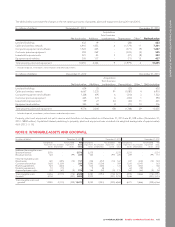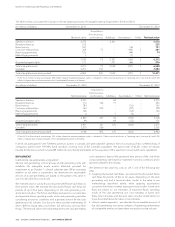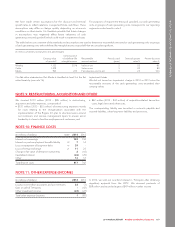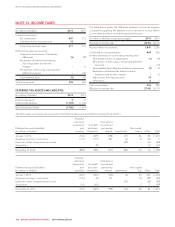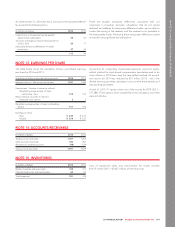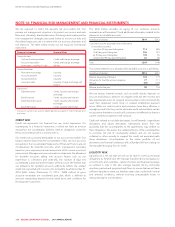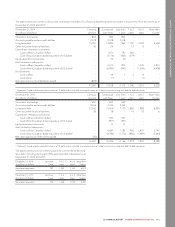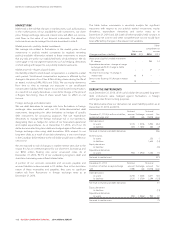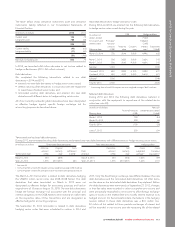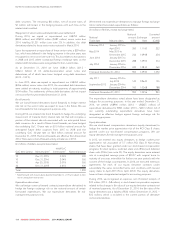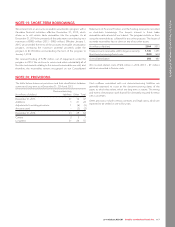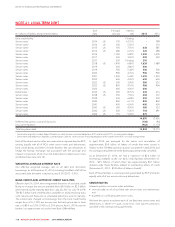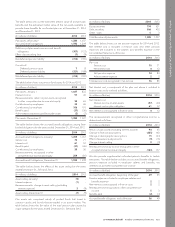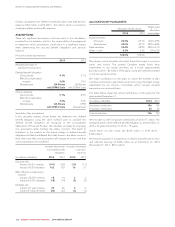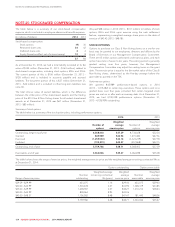Rogers 2014 Annual Report Download - page 118
Download and view the complete annual report
Please find page 118 of the 2014 Rogers annual report below. You can navigate through the pages in the report by either clicking on the pages listed below, or by using the keyword search tool below to find specific information within the annual report.
NOTES TO CONSOLIDATED FINANCIAL STATEMENTS
debt securities. The remaining $8 million, net of income taxes of
$1 million, will remain in the hedging reserve until such time as the
related debt is settled.
Repayment of senior notes and related derivative settlements
During 2014, we repaid or repurchased our US$750 million
($834 million) and US$350 million ($387 million) senior notes due
2014, totalling $1,221 million (see note 30). In addition, the debt
derivatives related to these senior notes matured in March 2014.
Upon the repayment or repurchase of these senior notes, a $29 million
loss, which was deferred in the hedging reserve in the prior years, was
recognizedinnetincome(seenote10).Thislossrelatestotransactions
in 2008 and 2013 where contractual foreign exchange rates on the
related debt derivatives were renegotiated to then current rates.
As at December 31, 2014 we have US$6.0 billion (2013 –
US$6.4 billion) of US dollar-denominated senior notes and
debentures, all of which have been hedged using debt derivatives
(2013 – 100 %).
In June 2013, when we repaid or repurchased our US$350 million
($356 million) senior notes due 2013, the associated debt derivatives
were settled at maturity, resulting in total payments of approximately
$104 million. The settlements of these debt derivatives did not impact
net income for the year ended December 31, 2014.
Bond forwards
We use bond forward derivatives (bond forwards) to hedge interest
rate risk on the senior notes we expect to issue in the future. We use
bond forwards for risk-management purposes only.
During 2014, we entered into bond forwards to hedge the underlying
Government of Canada (GoC) interest rate risk that will comprise a
portion of the interest rate risk associated with our anticipated future
debt issuances. As a result of these bond forwards, we have hedged
the underlying GoC 10-year rate on $1.5 billion notional amount for
anticipated future debt issuances from 2015 to 2018 and the
underlying GoC 30-year rate on $0.4 billion notional amount for
December 31, 2018. The bond forwards are effective from December
2014. There was no bond forward activity or balances in 2013.
(In millions of dollars, except interest rates)
GoC term (years) Maturity date 1
Initial GoC
Interest rate 1Notional amount
10 Dec 31, 2015 2.05% 500
10 Dec 31, 2016 2.04% 500
10 Apr 30, 2018 2.07% 500
30 Dec 31, 2018 2.41% 400
Total 1,900
1Bond forwards with maturity dates beyond December 31, 2015 are subject to GoC
rate re-setting from time to time.
Expenditure derivatives
We use foreign currency forward contracts (expenditure derivatives) to
hedge the foreign exchange risk on the notional amount of certain
forecasted expenditures. We use expenditure derivatives for risk-
management purposes only.
We entered into expenditure derivatives to manage foreign exchange
risk on certain forecasted expenditures as follows:
(In millions of dollars, except exchange rates)
Notional
Trade date Maturity dates
Notional
amount
(US$)
Exchange
Rate
Converted
amount
(Cdn$)
February 2014 January 2015 to
April 2015 200 1.1100 222
May 2014 May 2015 to
December 2015 232 1.0948 254
June 2014 January 2015 to
December 2015 288 1.0903 314
July 2014 January 2016 to
December 2016 240 1.0833 260
Total as at December 31, 2014 960 1.0940 1,050
July 2011 January 2014 to
July 2014 140 0.9643 135
September 2013 January 2014 to
December 2014 760 1.0368 788
Total as at December 31, 2013 900 1.0256 923
The expenditure derivatives noted above have been designated as
hedges for accounting purposes. In the year ended December 31,
2014, we settled US$900 million (2013 — US$435 million) of
expenditure derivatives for $923 million (2013 — $430 million). All of
our currently outstanding expenditure derivatives have been
designated as effective hedges against foreign exchange risk for
accounting purposes.
Equity derivatives
We use stock-based compensation derivatives (equity derivatives) to
hedge the market price appreciation risk of the RCI Class B shares
granted under our stock-based compensation programs. We use
equity derivatives for risk-management purposes only.
In 2013, we entered into equity derivatives to hedge market price
appreciation risk associated of 5.7 million RCI Class B Non-Voting
shares that have been granted under our stock-based compensation
programs for stock options, restricted share units (RSUs) and deferred
share units (DSUs) (see note 25). The equity derivatives were entered
into at a weighted average price of $50.37 with original terms to
maturity of one year, extendible for further one year periods with the
consent of the hedge counterparties. In 2014, we executed extension
agreements for each of our equity derivative contracts under
substantially the same committed terms and conditions with revised
expiry dates to April 2015 (from April 2014). The equity derivatives
have not been designated as hedges for accounting purposes.
During 2014, we recognized an expense, net of interest receipts of
$10 million (2013 — $8 million), in stock-based compensation expense
related to the change in fair value of our equity derivative contracts net
of received payments. As of December 31, 2014, the fair value of the
equity derivatives was a liability of $30 million (December 31, 2013 —
$13 million), which is included in the current portion of derivative
instruments liabilities.
114 ROGERS COMMUNICATIONS INC. 2014 ANNUAL REPORT



